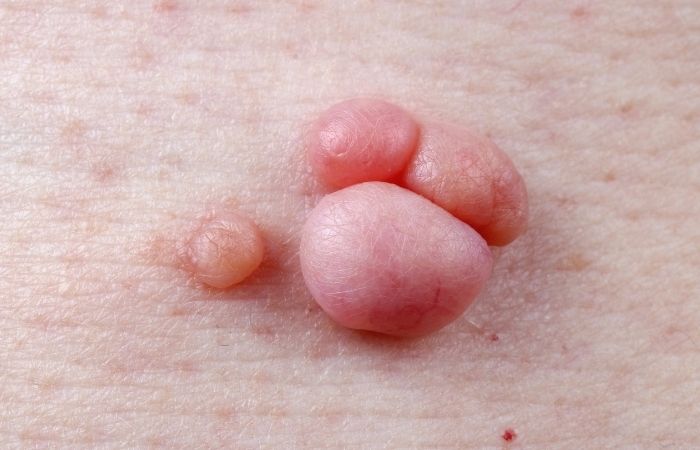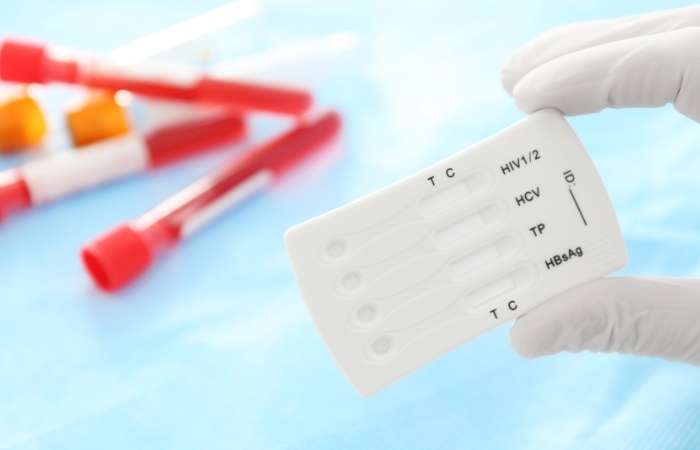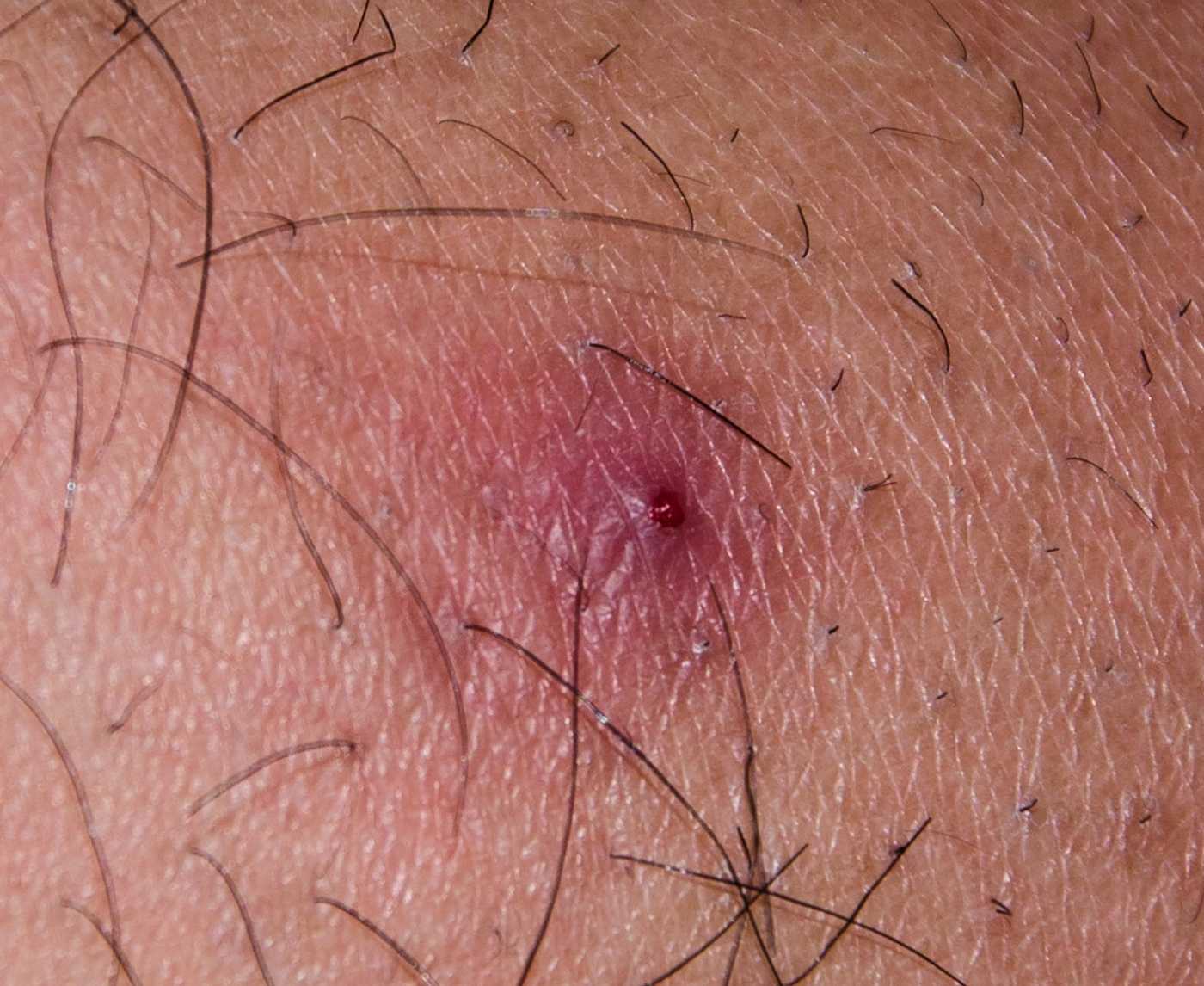How Accurate Are Syphilis Rapid Tests in 2025?
Quick Answer: Syphilis sores are usually painless, round, and firm; herpes blisters tend to be painful, clustered, and fluid-filled. Only a test can confirm for sure.
Why This Mix-Up Happens So Often
It makes sense that people confuse syphilis and herpes. Both can cause genital sores. Both can be caught during oral, vaginal, or anal sex. Both can show up weeks after the encounter that caused them. And both can appear when you least expect them, like during a period of monogamy, after shaving, or when you’ve had zero other symptoms.
But here’s the kicker: herpes and syphilis behave very differently under the surface. One is a virus that lives in your nerves and flares unpredictably. The other is a bacterial infection that progresses in stages if left untreated. That means your symptoms, risk level, and testing window aren’t just different, they’re critical for understanding what’s happening to your body.

People are also reading: HIV vs. Syphilis: Which One Is More Common in Florida Right Now?
What a Syphilis Sore Feels Like (Or Doesn’t)
Syphilis starts with a single sore, called a chancre, that shows up anywhere the bacteria entered your body. That could be your penis, vulva, vagina, anus, lips, tongue, or even inside your mouth or throat. The hallmark? It usually doesn’t hurt at all.
The sore is round or oval, raised or flat, and feels firm when you touch it. No itching, no tingling, no burning. Just… there. You might miss it entirely, especially if it’s in an area you don’t check often. And then it vanishes within a few weeks on its own.
But that’s when the real danger starts. Without treatment, syphilis moves into a secondary stage with body rashes (especially on your palms or soles), swollen lymph nodes, fatigue, or hair loss. It’s sneaky, systemic, and sexually transmissible even when you feel “fine.”
Herpes Blisters: Small, Painful, and Grouped
Herpes shows up differently. When HSV-1 or HSV-2 causes a genital outbreak, the blisters often start with itching, burning, or tingling. Within a day or two, small fluid-filled bumps appear in clusters. These can hurt like hell, especially if you’re peeing, walking, or wearing tight underwear.
The blisters usually burst within a few days and turn into shallow ulcers or scabs. Outbreaks typically last 7 to 14 days, but the timeline can vary depending on your immune system and whether it’s your first episode or a recurrence.
Unlike syphilis, herpes never fully leaves your body. After the initial outbreak, it hides in your nerve cells and can reactivate, especially during stress, illness, or menstruation. You might have one outbreak per year, or several. Some people have none at all and still spread it to partners through asymptomatic shedding.
Table: Syphilis vs Herpes Symptoms at a Glance
Figure 1. This comparison chart highlights key differences between syphilis and herpes symptoms. Remember, visual cues aren’t enough, testing is always the next step.
"They Told Me It Was Razor Burn. It Wasn't."
Jordan, 32, noticed a small sore near their inner thigh after shaving. It didn’t hurt, didn’t swell, and didn’t ooze. A walk-in clinic doctor guessed it was razor burn. A week later, Jordan developed a rash on their arms and swollen glands under their jaw. Another test, this time a blood test, came back positive for syphilis.
"I didn’t even know you could have syphilis and not feel sick," Jordan says. "I thought if it didn’t hurt, it wasn’t serious."
This is why we need better public education around STD symptoms. Many people expect drama, pain, pus, redness, but infections like syphilis can slip by without a single signal. Herpes, on the other hand, can feel like fire even during a tiny breakout.
What Kind of Test Do You Actually Need?
If you’re reading this because you noticed a bump, sore, or rash and you’re panicking, pause. No one can confirm syphilis or herpes just by looking. Even experienced doctors rely on testing. And the kind of test you need depends on when your symptoms started and what type of exposure you had.
Herpes can be tested through a swab (if sores are present) or a blood test (to detect antibodies). Swabs are more accurate during active outbreaks. Blood tests can confirm past exposure but won’t tell you when you got infected or if the virus is active.
Syphilis requires a blood test, usually one that looks for antibodies. In some cases, a doctor might swab a chancre or use dark-field microscopy, but that’s rare and usually only in specialized clinics. The gold standard is a two-step blood test that checks for both current infection and past exposure.
Table: Herpes vs Syphilis Testing Options
Figure 2. Choose a test based on timing and symptoms. Herpes swabs must be done early, while syphilis blood tests require patience for accuracy.
When to Test: Timing Is Everything
Let’s break down the timelines, because testing too early can give you a false negative, and testing too late might miss the window for early treatment. Here’s what you need to know:
If you’re under 7 days post-exposure and have no symptoms, it's too soon to test for either herpes or syphilis. If symptoms appear during that time (like a sore or blister), a herpes swab may still catch it. But a syphilis blood test likely won’t detect anything yet.
If you’re 14 to 21 days after exposure, this is the optimal window for early herpes antibody tests and syphilis screening. If a syphilis chancre appeared and disappeared already, antibodies are likely detectable now.
If you’re 30+ days out and still uncertain, a blood test for both is strongly recommended, especially if you've had multiple partners or aren’t sure when exposure occurred.
And remember: no matter when you test, if symptoms persist or evolve, retesting is often part of the process.
“I Tested Negative. Then Two Weeks Later, I Got the Real Answer.”
Sabrina, 27, got tested at an urgent care clinic five days after a hookup where the condom broke. She’d noticed no symptoms yet but felt anxious. Her tests for everything came back negative, and she thought she was in the clear.
“Then I got a cluster of painful little sores on my vulva. It was like tiny ulcers that stung just from moving. I went back and did a swab for herpes. It was positive.”
Her story is common. Early testing often gives a false sense of relief, but herpes antibodies take time to develop, and syphilis antibodies may not be detectable until weeks later. That’s why experts often recommend retesting after 4 to 6 weeks, especially if your exposure was high-risk or your symptoms don’t align with your results.

People are also reading: When the STD Test Says “Negative” But Your Body Says “Something’s Wrong”
At Home or In Clinic? Pros and Cons
There are accurate, FDA-cleared at-home tests for both herpes (blood-based antibody tests) and syphilis (rapid treponemal tests). But they’re not all created equal, and your decision should be based on how fast you need results and what you’re comfortable collecting.
Here’s what to consider:
- Privacy: At-home tests let you avoid clinic stigma. They arrive discreetly and let you collect samples in your own space.
- Speed: Some rapid test kits show results in 15–20 minutes. Lab-based mail-ins can take 2–3 days.
- Accuracy: Timing matters more than location. A clinic won’t make a test more accurate if you take it too early.
If you’re unsure where to start, you can order a combined STD test kit that screens for multiple infections in one go, including both syphilis and herpes.
Why Retesting Isn’t a Sign of Weakness, It’s Just Smart
There’s a stigma around needing to “go back” for more tests, as if getting retested means you were wrong the first time. But that’s not how biology works. STD testing has window periods, and your immune system might just not be ready to give a clear answer yet.
In fact, many clinics will tell you upfront: test now, then test again in 3 to 6 weeks if symptoms develop or risk was high. Retesting is especially important if you had:
- An early negative result but symptoms later
- Multiple partners in a short timeframe
- A partner who just tested positive for herpes or syphilis
- Unclear or changing symptoms
If your gut is telling you something’s off, even after one round of tests, listen to it.
When It’s Not What You Think: The Danger of Misdiagnosis
One of the biggest risks with both syphilis and herpes is not just catching the infection, but misreading the signs. Doctors and patients alike often mistake herpes for ingrown hairs, shaving bumps, or even allergic reactions. Syphilis gets written off as friction burns, dry skin, or an “unusual zit.”
That’s partly because the symptoms overlap with so many benign issues, and partly because sexual health training still lags in many medical programs. A study published in the JAMA Internal Medicine found that many primary care providers under-recognize syphilis signs during physical exams, especially when the presentation is mild or internal.
This is why symptom-checking apps and visual comparison tools can only go so far. If it’s persistent, recurring, or doesn’t respond to standard skin treatments, test. That one step can prevent months of confusion and the risk of passing the infection unknowingly to a partner.
The Symptom That Fools Everyone: Painless Sores
Here’s a detail most people don’t expect: syphilis sores are often totally painless. In fact, that’s part of what makes them so stealthy. A small, raised bump near the anus, on the labia, or under the foreskin might not be noticed at all, especially if you assume an STD would hurt.
Compare that to herpes, which tends to be loud: itchy, hot, irritated, and uncomfortable. If you’ve got blisters that sting when you pee, rub against your clothes, or make sitting miserable, herpes jumps much higher on the list.
But don’t use pain as your only indicator. Many people have mixed symptoms, mild outbreaks, or other conditions entirely. Always consider testing both if you’re sexually active and haven’t ruled them out through accurate lab work.
Silent Infections: Can You Have Herpes or Syphilis Without Symptoms?
Short answer: yes. Long answer: it’s shockingly common. Let’s break it down.
Herpes: Up to 90% of people don't know they have it, because some people never have noticeable outbreaks or think they are just small skin problems. They can still spread the virus and make other people sick, even if they don't have any sores.
Syphilis: Because the initial sore is painless and often internal (vaginal canal, rectum, throat), many people never realize they’ve been infected. The secondary stage, which might include rash, fatigue, fever, or hair thinning, can also be misattributed to other illnesses or skipped entirely. That’s why syphilis is often nicknamed “the great imitator.”
If you’ve had unprotected sex, multiple partners, or a partner who tested positive, even without symptoms, it’s worth testing. Silence doesn’t equal safety.

People are also reading: Can You Still Have Sex If You Have Chlamydia?
“We Both Thought We Were Clean, Until He Got Sick”
Diego, 36, had been in a monogamous relationship for nearly a year when his boyfriend developed a mysterious rash on his hands and chest. They’d both tested before becoming exclusive, but the doctor diagnosed it as secondary syphilis. Diego tested too, and was positive, too.
“I felt sick, embarrassed, angry. We thought we did everything right. But he must have had it from before, and it never showed up until now.”
Infections can lie dormant, or appear outside window periods. Relationship trust doesn’t replace lab results. And syphilis, in particular, can remain in your system for months before triggering symptoms or positive results.
Re-testing isn’t a betrayal. It’s prevention. A routine screen, even when you feel “clean”, can catch an infection before it progresses or spreads.
Stigma Keeps People Guessing, Let’s Break That Cycle
A lot of people don't want to get tested because they don't want to know what it means to have syphilis or herpes. The stigma is very strong, and it comes from old-fashioned sex education, moral judgments, and social shame. But here's the truth: both infections are common, treatable, and nothing to be ashamed of.
Over 500 million people globally have genital herpes, according to the World Health Organization. Syphilis cases are climbing worldwide, particularly among young adults and men who have sex with men. These aren’t fringe issues. They’re part of our sexual landscape.
Testing doesn't make you dirty; it makes you smart. Knowing your status helps keep you and your partners safe, lets you talk honestly, and gives you peace of mind. No matter what your result is, you still deserve love, connection, and pleasure.
FAQs
1. Can you have both syphilis and herpes at once?
Unfortunately, yes, and it happens more often than you’d think. If you’ve had unprotected sex, especially with multiple partners, it’s possible to contract both. They don’t cancel each other out. One is viral, one is bacterial. Different bugs, same body. That’s why testing for just one isn’t enough if you’re unsure what that sore really is.
2. Are herpes outbreaks always super painful?
Not always. Some people get fire-in-your-underwear kind of pain, while others barely feel a thing. The first outbreak tends to hit the hardest. After that, they might show up as tiny red bumps, barely noticeable, but still contagious. So even if it doesn’t feel like “a big deal,” it could still be herpes.
3. I found a bump but it doesn’t hurt. Can it still be syphilis?
Yes. That’s syphilis’s whole game, it’s sneaky. A painless, firm, round sore that doesn’t itch or burn? Classic primary syphilis. You could easily miss it if it’s inside the vagina, rectum, or mouth. No symptoms does not mean no problem.
4. What if I tested negative for herpes but still have symptoms?
Timing matters. If you tested too soon, especially with a blood test, your body may not have made enough antibodies yet. Swab tests are more accurate during an active outbreak, ideally within 48 hours of seeing the sores. Still not sure? Retest in a few weeks. Your symptoms are real, even if your test isn’t showing it yet.
5. Do syphilis rashes only show up on your hands?
Nope. The rash of secondary syphilis can show up on your palms and soles (which is weird and super specific), but it can also pop up on your chest, back, or thighs, and look like dry skin or tiny reddish dots. It doesn’t itch much, which is why it’s easy to miss. Weird rash that won’t go away? Worth testing.
6. If I had herpes once, does that mean I’ll always have outbreaks?
Not necessarily. Some people only get one outbreak ever. Others have several a year. Over time, outbreaks usually get milder and less frequent. Antiviral meds can help reduce how often they show up, and how likely you are to pass it on.
7. How long after sex should I wait to test for syphilis or herpes?
Wait at least 3 weeks for syphilis and 4–6 weeks for herpes blood tests. If you have active symptoms like blisters or sores, a swab for herpes can be done immediately, ideally within 48 hours of appearance.
8. Can herpes or syphilis show no symptoms at all?
Yes, both can be completely symptomless. Herpes can spread without causing visible outbreaks, and syphilis can go through its early stages without anyone noticing. If you've had sex without protection, you need to get tested even if you don't have any symptoms.
9. What if I get a false negative?
It happens. Testing too early is the biggest reason. If symptoms persist or your exposure risk was high, retesting after the window period is recommended. Use testing timelines as a guide, not a guarantee.
10. Can herpes or syphilis be cured?
If caught early, a single shot of penicillin can cure syphilis. You can't get rid of herpes, but you can control it. Antiviral drugs can lower the risk of transmission and the number of outbreaks.
Get The Answers You Deserve
People shouldn't have to guess what's wrong with their bodies. The first step to getting your life back is to find out if you have herpes or syphilis, no matter how bad your symptoms are.
Test discreetly, treat confidently, and don’t let shame be louder than your health. You’re not alone, and you’re not stuck.
Don’t wait and wonder, get the clarity you deserve. This at-home combo test kit checks for the most common STDs discreetly and quickly.
How We Sourced This Article: We combined current guidance from leading medical organizations with peer-reviewed research and lived-experience reporting to make this guide practical, compassionate, and accurate. In total, around fifteen references informed the writing; below, we’ve highlighted six of the most relevant and reader-friendly sources.
Sources
1. WHO – Herpes Simplex Virus Fact Sheet
2. Planned Parenthood – Herpes 101
3. NEJM – Syphilis in the Modern Era
4. Syphilis — Symptoms & Causes | Mayo Clinic
5. Genital Herpes — Symptoms & Causes | Mayo Clinic
6. CDC Treatment Guidelines for Genital Herpes
About the Author
Dr. F. David, MD is a board-certified infectious disease specialist who works to stop, diagnose, and treat STIs. He combines clinical accuracy with a straightforward, sex-positive attitude and is dedicated to making his work available to more people, both in cities and in rural areas.
Reviewed by: Dr. Talia R. Brooks, MD | Last medically reviewed: September 2025








